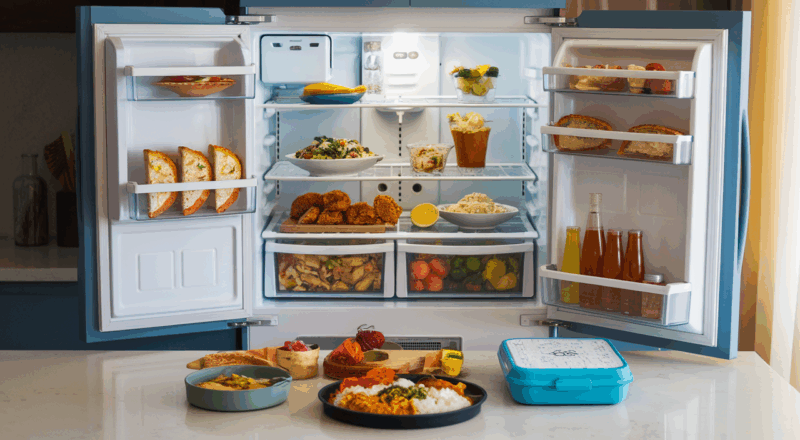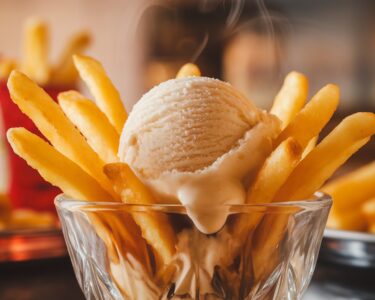The cold leftovers food freedom trend breaks down traditional eating rules as more people enjoy meals straight from the fridge, appreciating both their practical benefits and the science behind why certain foods taste better cold.
Key Takeaways
- Eating cold leftovers saves time (5-15 minutes per meal) and energy while offering greater schedule flexibility for busy lifestyles.
- Many dishes develop deeper flavors overnight in the refrigerator, creating new texture experiences as aromatic compounds mellow and fats solidify.
- Foods particularly well-suited for cold consumption include pizza, fried chicken, pasta salads, grain bowls, and quiche.
- Proper food safety requires storing leftovers within 2 hours of cooking, keeping your refrigerator at or below 40°F, and consuming items within 3-4 days.
- This trend aligns with other modern eating movements like intuitive eating, challenging Western notions that “proper” meals must be served hot.
The Rise of Cold Leftovers
I’ve noticed more people skipping the microwave and eating leftovers straight from the fridge. This isn’t just about convenience—though saving those precious minutes does matter. The cold leftovers trend reflects a deeper shift in how we approach food, focusing on personal enjoyment rather than following strict culinary rules.
Cold pizza for breakfast doesn’t need an apology anymore. In fact, science backs up what many food lovers already know: certain dishes actually develop better flavors after resting in the refrigerator overnight. The chemistry changes as aromatic compounds blend and mellow, creating entirely new taste experiences.
Benefits of Eating Cold Leftovers
- Time savings: No reheating means quicker meals, especially helpful during busy mornings or work breaks.
- Flavors intensify: Cooling enhances the taste of many foods, particularly those with complex seasonings and fats.
- Decreased waste: Cold meals are more appealing and less likely to be thrown away.
- Energy efficiency: Avoiding the microwave reduces electricity usage.
Challenging Food Norms
This approach to eating saves significant time each day, eliminates unnecessary food waste, and gives you complete freedom over your eating schedule. It’s part of a broader movement that prioritizes individual preferences and questions why we’ve been taught certain foods must always be served hot.
Breaking Free from Hot Meal Rules: Why Cold Leftovers are the New Normal
The Cold Leftovers Food Freedom Trend Revolution
I’ve noticed a refreshing shift in how people approach their meals. The cold leftovers food freedom trend is breaking down outdated rules about proper eating. Gone are the days when reheating every leftover meal was a must-do ritual. Instead, more folks are embracing the simple joy of eating straight from the fridge.
This movement pairs perfectly with other relaxed eating styles, like casual solo dinner experiences and creative plating arrangements. It’s part of a bigger push toward intuitive eating and letting go of rigid food rules.
Practical Benefits Behind the Cold Leftovers Food Freedom Trend
The advantages of embracing cold leftovers go beyond just challenging social norms. Here’s what makes this trend so appealing:
- Time Savings: Skipping the reheat saves 5–15 minutes per meal
- Energy Efficiency: Avoiding microwave use (700–1300 watts per use)
- Schedule Flexibility: Perfect for busy days and quick lunches
- Convenience: Ideal for office breaks or casual snacking routines
I’ve found that cold leftovers can be just as satisfying as their heated counterparts. Many dishes actually develop deeper flavors overnight in the fridge, making them tastier the next day. This approach fits perfectly with modern lifestyles where convenience matters, but so does staying true to your food preferences.
The cold leftovers food freedom trend also challenges the Western idea that a “proper” meal needs to be hot. Just like personalized lunch boxes reflect individual style, eating cold leftovers shows how personal food choices can be. It’s about listening to your body and eating what feels right, when it feels right.
This shift isn’t just about being rebellious – it’s about finding what works best for your lifestyle while saving time and energy. Whether it’s cold pizza for breakfast or chilled pasta for lunch, the focus is on enjoyment rather than following arbitrary rules about how food should be consumed.
The Science Behind Why Some Foods Taste Better Cold
The cold leftovers food freedom trend isn’t just a lazy way to eat – there’s actual science backing up why certain dishes shine straight from the fridge. I’ve noticed this movement gaining momentum, especially among busy professionals who’ve discovered that some meals actually improve with a cool-down.
Temperature’s Impact on Flavor and Texture
The cold leftovers food freedom trend has revealed fascinating changes in how we experience food at different temperatures. When foods chill, their aromatic compounds become less volatile, which can mellow out overwhelming flavors in dishes like leftover curry or pasta dishes. Fats solidify at lower temperatures, creating new texture experiences—think about how the cheese on cold pizza firms up perfectly.
Here are some foods that really shine when served cold:
- Pizza – The cheese and toppings meld together beautifully
- Fried chicken – The coating becomes satisfyingly firm
- Pasta salads – The noodles absorb more flavor over time
- Grain bowls – All components maintain their distinct textures
- Quiche – The egg filling becomes extra creamy
Why Next-Day Flavors Pack More Punch
The cold leftovers food freedom trend has highlighted how time affects taste development. When dishes like stews and curries rest overnight, their flavors have more time to develop and combine. I’ve found that creating aesthetic snack plates with chilled leftovers can be just as satisfying as hot meals.
This shift in temperature affects how complex dishes interact with our taste buds. Chilled foods experience changes in their physical structure—starches firm up, and fats solidify, creating new textural experiences. However, not everything works cold. Some dishes to avoid cooling include:
- Greasy foods that congeal unpleasantly
- Clear soups that become gelatinous
- French fries that turn rubbery
- Hot beverages that lose their appeal
For those exploring creative bento box combinations, incorporating cold leftovers can add exciting variety. The trend aligns perfectly with modern meal prep strategies, saving time while offering unique culinary experiences. I’ve seen more people embracing creative snacking routines that incorporate these chilled dishes.
Safe Cold Leftover Practices You Need to Know
The cold leftovers food freedom trend has taken social media by storm, with food enthusiasts sharing their favorite ways to enjoy yesterday’s meals straight from the fridge. While this trend brings a fresh perspective to meal enjoyment, it’s crucial to handle leftovers safely.
Temperature Control and Timing for the Cold Leftovers Food Freedom Trend
According to the USDA and FDA, proper temperature management is essential. I’ve found these key steps help maintain food safety:
- Cool food quickly and store within 2 hours of cooking
- Reduce storage time to 1 hour when temperatures exceed 90°F
- Set your refrigerator temperature at or below 40°F
- Use leftovers within 3-4 days maximum
Smart Storage Solutions for Cold Meal Success
Just like creating a perfect snack plate aesthetic, proper storage is key to enjoying cold leftovers safely. The cold leftovers food freedom trend doesn’t mean throwing caution to the wind – I recommend paying special attention to these high-risk foods:
- Rice: Store promptly to prevent Bacillus cereus growth
- Seafood: Consume within 1-2 days for best safety
- Proteins: Keep in sealed containers on upper shelf
If you’re interested in incorporating this trend into your routine, like those practicing sad girl dinner habits, always use airtight containers. This prevents cross-contamination and keeps food fresh longer. I’ve noticed this movement gaining particular momentum on TikTok and Instagram under #coldleftovers and #foodfreedom hashtags.
For anyone creating zodiac-inspired bento boxes, the cold leftovers food freedom trend offers exciting possibilities for next-day lunches. Just make sure to follow these safety guidelines while exploring creative meal combinations.
Want to jazz up your cold leftover game? Try incorporating elements from the popular soft girl snack routine by adding fresh garnishes or a drizzle of sauce just before eating. This adds new life to your safely stored leftovers while maintaining food safety standards.
More people are embracing relaxed eating habits, like savoring last night’s pizza cold from the fridge, as discussed in this lively online conversation about chilled leftovers.
Sources:
USDA Food Safety and Inspection Service: Leftovers and Food Safety
FDA: Food Safety Charts
EPA: From Farm to Kitchen: The Environmental Impacts of U.S. Food Waste







